View in other NatureServe Network Field Guides
NatureServe
Montana
Utah
Wyoming
Idaho
Wisconsin
British Columbia
South Carolina
Yukon
California
New York
Deepwater Sculpin - Myoxocephalus thompsonii
State Rank Reason (see State Rank above)
Species is known from a single observation in one waterbody.
General Description
The Deepwater Sculpin is one of the most poorly known native freshwater fishes in North America (Parker 1988). It reaches 23 cm (9.0 in.) in length, but is usually smaller; the first two collected in Upper Waterton Lake (McAllister and Ward 1972) were 2.7 and 4.8 cm (1.1 and 1.9 in.) standard length. There is a large gap between the two dorsal fins, and a series of bony plates along the lateral line. The head is extremely wide and flat, and the mouth extends to below the eye. Large diskline scales are present on the back and sides above the lateral line. Large males have a very large 2nd-dorsal and pectoral fins. The lateral line is complete (in western populations). There are four preopercular spines, the upper two large and directed upward, the lower two directed downward. Overall appearance includes dark brown to green mottling, often with 4-7 green saddles, on a gray-brown back and sides, with a whitish belly (Page and Burr 1991).
For a comprehensive review of the ecology, conservation status, threats, and management of this and other Montana fish species of concern, please see
Montana Chapter of the American Fisheries Society Species of Concern Status Reviews.Diagnostic Characteristics
The very large gap between the dorsal fins distinguishes Deepwater Sculpin from other sculpins in Montana. The tips of the rays on the 2nd dorsal fin extend freely beyond the fin, also unlike in other Montana sculpins.
Species Range
Montana Range
Range Descriptions
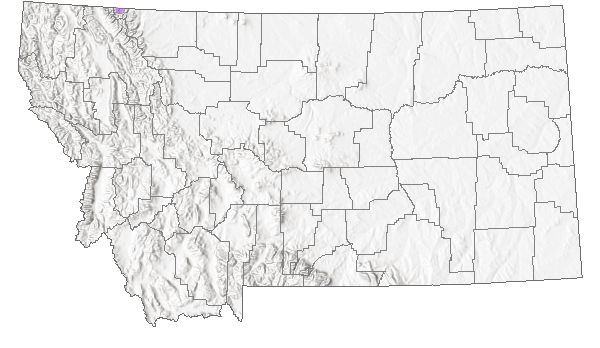
 Native
Native
Western Hemisphere Range
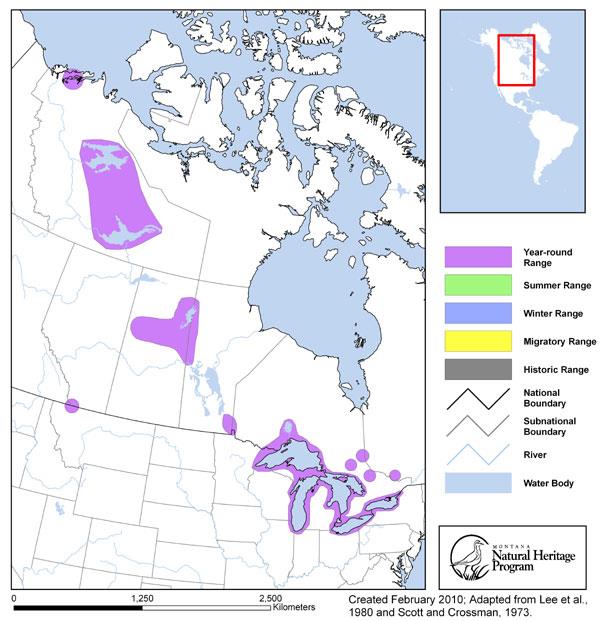
Range Comments
Deepwater Sculpins are found in North American lakes of the Hudson Bay drainages from the Northwestern Territories of Canada to the Great Lakes Drainages of the eastern United States, Ontario and Quebec that have glacial origins or have been affected during the last glacial period. In Montana, one lake in Glacier National Park (Upper Waterton Lake) has been identified as an occurrence site, but the fish has been taken from the lake only in the Canadian portion. Total documented global range includes, at most, 63 lakes.
Observations in Montana Natural Heritage Program Database
Number of Observations: 1
(Click on the following maps and charts to see full sized version)
Map Help and Descriptions
Relative Density
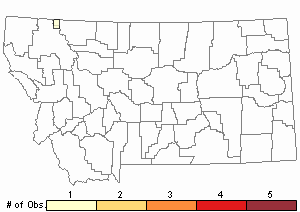
Recency
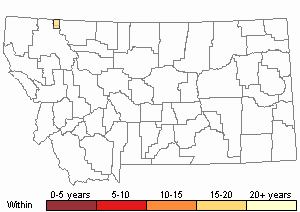
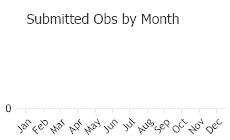
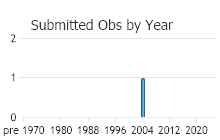
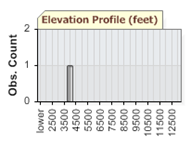 (Observations spanning multiple months or years are excluded from time charts)
(Observations spanning multiple months or years are excluded from time charts)
Migration
No information. Populations in lakes remain in those lakes, but movements within lakes has not been described. Current geographic distribution is thought to be a result of dispersal during the Pleistocene through glacial lakes, inland seas, and their outlets; the dispersal to Upper Waterton Lake may have occurred subsequent to the last continental ice sheet advance (Sheldon et al. 2008).
Habitat
The Deepwater Sculpin appears to remain near the bottom in deep oligotrophic glacial lakes, but habitat descriptions are limited because of the difficulty of capture or detection; the record depth is about 366 m (1200 ft) in both Great Bear Lake and Lake Superior (Scott and Crossman 1973). All lakes occupied in a 2004 survey had relatively low nutrient concentrations and low biological production rates, maximum water depths exceeding 35 m (115 ft) and benthic water temperatures below 8 C during summer. (Sheldon et al. 2008).
Food Habits
The Deepwater Sculpin is a benthic invertivore, feeding on deepwater crustaceans (amphipods); and larval chironomids (Black and Lankester 1981, Brandt 1986; Kraft and Kitchell 1986). In Lake Huron and Lake Michigan, Mysis relicta forms the primary diet, supplemented with Diporeia species; both are glacial-relict crustaceans (Hondorp et al. 2011).
Ecology
The Deepwater Sculpin inhabits the bottoms of deep lakes and is an important forage fish for lake trout, burbot, and other cold water piscivores (Scott and Crossman 1973). It feeds on deepwater crustaceans (amphipods) and larval chironomids. A 2004 survey of 35 lakes across their range never found Deepwater and Spoonhead Sculpins (Cottus ricei) together within the same lakes, suggesting competition between these two species (Sheldon et al. 2008). In Lake Michigan, Deepwater Sculpin accounts for 30% of fish biomass caught in bottom trawls (Bunnell et al. 2009). Energy density of sculpins declined in Lake Michigan with the collapse of Diporeia prey (Hondorp et al. 2011). Two Deepwater Sculpins were captured in Upper Waterton Lake in August 1966, 28 were captured during May to October 2004, using benthic fish traps, gill nets, and otter trawls; population size in the lake is unknown. Nine of 10 Deepwater Sculpins from Upper Waterton Lake were infected with immature forms of the internal parasite Bothriocephalus cuspidatus, and four of ten with immature Proteocephalus sp. Adults of these parasites are found in Lake Trout or Burbot, both of which are important predators of Deepwater Sculpins. Thus, the diet of Deepwater Sculpins reflects the mode of parasite recruitment through its main prey of crustaceans (which host immature stages of the parasites); furthermore, Deepwater Sculpins play a role in the life cycle of these parasites by transmitting them to deepwater picivorous fish (Carney et al. 2009).
Reproductive Characteristics
In Lake Michigan, Deepwater Sculpins lay benthic eggs in off-shore waters. Eggs hatch between November and August, with peak hatching in March. Abundance of larvae in pelagic samples was greater offshore than inshore. Larvae reach metamorphosis at 2.0 cm (0.8 in.) and settle to the bottom beginning in July. Pelagic larvae 2.0 to 4.0 cm (0.8 to 1.6 in.) in length were found in the lower water column, but newly settled larvae were found only in bottom trawls at less than 60 m depth. Successful settlement by larvae extended only to the depth above adult occupancy. Maximum density of larvae reached 0.4 individuals per cubic meter by June. Survival from pelagic larvae to the demersal young-of-year stage was about 0.1 to 0.4% (Geffen and Nash 1992).
Management
No management activities specific to Deepwater Sculpin are currently occurring in Montana. The only known location for Montana is within the boundaries of Glacier National Park and Waterton Lake National Park, Alberta. Surveys conducted at Upper Waterton Lake, which overlaps the international boundary, have captured Deepwater Sculpin in the Canadian portion (McAllister and Ward 1972, Sheldon et al. 2008); the U.S. portion has not been sampled. Surveys of other deepwater lakes in and near Glacier National Park would be useful, as well as routine surveys of Upper Waterton Lake (including the U.S. portion) to determine the status and distribution of Deepwater Sculpin in that lake.
Stewardship Responsibility
Threats or Limiting Factors
No significant specific threats have been identified. The current distribution is static because the species does not move between lakes, making it vulnerable to local extirpation should current lake habitats become eutrophied or disturbed. Deepwater Sculpin were not detected in two Canadian lakes now relatively eutrophic or mesotrophic, but which were previously occupied (Sheldon et al. 2008).
References
- Literature Cited AboveLegend:
 View Online Publication
View Online Publication Black, G. A. and M. W. Lankester. 1981. The biology and parasites of deepwater sculpin, Myoxocephalus quadricornis thompsonii (Girard), in Burchell Lake, Ontario. Canadian Journal of Zoology 59(7): 1454-1457.
Black, G. A. and M. W. Lankester. 1981. The biology and parasites of deepwater sculpin, Myoxocephalus quadricornis thompsonii (Girard), in Burchell Lake, Ontario. Canadian Journal of Zoology 59(7): 1454-1457. Brandt, S. B. 1986. Disappearance of the deepwater sculpin (Myoxocephalus Thompsoni) from Lake Ontario: the keystone predator hypothesis. Journal of Great Lakes Research 12(1): 18-24.
Brandt, S. B. 1986. Disappearance of the deepwater sculpin (Myoxocephalus Thompsoni) from Lake Ontario: the keystone predator hypothesis. Journal of Great Lakes Research 12(1): 18-24. Bunnell, D.B., C.P. Madenjian, J.D. Holuszko, J.V. Adams, and J.R.P. French III. 2009. Expansion of Dreissena into offshore waters of Lake Michigan and potential impacts on fish populations. Journal of Great Lakes Research 35(1): 74-80.
Bunnell, D.B., C.P. Madenjian, J.D. Holuszko, J.V. Adams, and J.R.P. French III. 2009. Expansion of Dreissena into offshore waters of Lake Michigan and potential impacts on fish populations. Journal of Great Lakes Research 35(1): 74-80. Carney J.P., T.A. Sheldon, and N.R. Lovejoy. 2009. Parasites of the deepwater sculpin (Myoxocephalus thompsonii) across its Canadian range. The Journal of Parasitology 95(5): 1209-12.
Carney J.P., T.A. Sheldon, and N.R. Lovejoy. 2009. Parasites of the deepwater sculpin (Myoxocephalus thompsonii) across its Canadian range. The Journal of Parasitology 95(5): 1209-12. Geffen, A.J. and R D.M. Nash. 1992. The life-history strategy of deepwater sculpin, Myoxocephalus thompsoni (Girard), in Lake Michigan: dispersal and settlement patterns during the first year of life. Journal of Fish Biology 41: 101-110.
Geffen, A.J. and R D.M. Nash. 1992. The life-history strategy of deepwater sculpin, Myoxocephalus thompsoni (Girard), in Lake Michigan: dispersal and settlement patterns during the first year of life. Journal of Fish Biology 41: 101-110. Hondorp, D. W., S. A. Pothoven, and S. B. Brandt. 2011. Feeding selectivity of slimy sculpin Cottus cognatus and deepwater sculpin Myoxocephalus thompsonii in southeast Lake Michigan: Implications for species coexistence. Journal of Great Lakes Research 37(1): 165-172.
Hondorp, D. W., S. A. Pothoven, and S. B. Brandt. 2011. Feeding selectivity of slimy sculpin Cottus cognatus and deepwater sculpin Myoxocephalus thompsonii in southeast Lake Michigan: Implications for species coexistence. Journal of Great Lakes Research 37(1): 165-172. Kraft, C.E. and J.F. Kitchell. 1986. Partitioning of food resources by sculpins in Lake Michigan. Environmental Biology of Fishes 16:309-316.
Kraft, C.E. and J.F. Kitchell. 1986. Partitioning of food resources by sculpins in Lake Michigan. Environmental Biology of Fishes 16:309-316. Lee, D.S., C.R. Gilbert, C.H. Hocutt, R.E. Jenkins, D. E. McAllister, J. R. Stauffer, Jr. 1980. Atlas of North American freshwater fishes. North Carolina State Musuem of Natural History. 867 p.
Lee, D.S., C.R. Gilbert, C.H. Hocutt, R.E. Jenkins, D. E. McAllister, J. R. Stauffer, Jr. 1980. Atlas of North American freshwater fishes. North Carolina State Musuem of Natural History. 867 p. McAllister, D.E. and J.C. Ward. 1972. The deepwater sculpin, Myoxocephalus quadricornis thompsoni, new to Alberta, Canada. Journal of Fisheries Research Board of Canada 29:344-345.
McAllister, D.E. and J.C. Ward. 1972. The deepwater sculpin, Myoxocephalus quadricornis thompsoni, new to Alberta, Canada. Journal of Fisheries Research Board of Canada 29:344-345. Page, L.M. and B.M. Burr. 1991. A field guide to freshwater fishes. The Peterson Field Guide Series, Houghton Mifflin Co., Boston. 432 pp.
Page, L.M. and B.M. Burr. 1991. A field guide to freshwater fishes. The Peterson Field Guide Series, Houghton Mifflin Co., Boston. 432 pp. Parker, B. J. 1988. Status of deepwater sculpin, Myoxocephalus thompsoni, in Canada. Canadian Field-Naturalist 102: 126-131.
Parker, B. J. 1988. Status of deepwater sculpin, Myoxocephalus thompsoni, in Canada. Canadian Field-Naturalist 102: 126-131. Scott, W.B. and E.J. Crossman. 1973. Rainbow trout, Kamloops trout, Steelhead trout Salmo gairdneri Richardson. pp. 184-191. In: Freshwater fishes of Canada. Ottawa, Canada: Fisheries Research Board of Canada, Bulletin 184. 966 p.
Scott, W.B. and E.J. Crossman. 1973. Rainbow trout, Kamloops trout, Steelhead trout Salmo gairdneri Richardson. pp. 184-191. In: Freshwater fishes of Canada. Ottawa, Canada: Fisheries Research Board of Canada, Bulletin 184. 966 p.
- Additional ReferencesLegend:
 View Online Publication
View Online Publication
Do you know of a citation we're missing? Bunnell, D.B., S.R. David, and C.P. Madenjian. 2009. Decline in bloater fecundity in Southern Lake Michigan after decline of Diporeia. Journal of Great Lakes Research 35(1): 45-49.
Bunnell, D.B., S.R. David, and C.P. Madenjian. 2009. Decline in bloater fecundity in Southern Lake Michigan after decline of Diporeia. Journal of Great Lakes Research 35(1): 45-49. Joslin, Gayle, and Heidi B. Youmans. 1999. Effects of recreation on Rocky Mountain wildlife: a review for Montana. [Montana]: Montana Chapter of the Wildlife Society.
Joslin, Gayle, and Heidi B. Youmans. 1999. Effects of recreation on Rocky Mountain wildlife: a review for Montana. [Montana]: Montana Chapter of the Wildlife Society. Sheldon, T.A., N.E. Mandrak, and N.R. Lovejoy. 2008. Biogeography of the deepwater sculpin (Myoxocephalus thompsonii), a Nearctic glacial relict. Canadian Journal of Zoology 86:108-115.
Sheldon, T.A., N.E. Mandrak, and N.R. Lovejoy. 2008. Biogeography of the deepwater sculpin (Myoxocephalus thompsonii), a Nearctic glacial relict. Canadian Journal of Zoology 86:108-115.
- Web Search Engines for Articles on "Deepwater Sculpin"
- Additional Sources of Information Related to "Fish"





